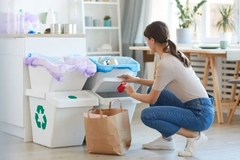US Plastics Pact report stresses need for material limitations and international policies for value chain progress

30 Aug 2024 --- US Plastics Pact has released an updated report detailing its stance to eliminating problematic and unnecessary materials from the plastics value chain. New approaches to circular design challenges, like fighting contamination in recyclables, are highlighted, along with additional material bans for products such as oxodegradables.
The report comes shortly after the US government shifted its position to support global production caps on plastic production, aligning with the “High Ambition Coalition” goals for a UN Plastic Treaty, which is set for a final round of negotiations in November.
Members of the Pact include major plastics and food producers like Unilever, Coca-Cola and General Mills.
“While we often focus on recycling, we can’t forget that outright reduction, reuse models and composting efforts are also important parts of a circular economy,” Jonathan Quinn, CEO of US Plastics Pact, tells Packaging Insights.
“The report exists to encourage increased engagement and innovation from companies throughout the plastics value chain, in hopes not merely to eliminate materials, but to discover potential new pathways to their circularity.”
While eleven items were listed for elimination by 2025 on the pact’s previous report, additional materials have now been added, including non-compostable produce stickers (targeted for elimination by 2030), multi-material plastic designs and oxodegradable additives.
Future steps
While items on the elimination list do not have a clear path to circularity, but for a variety of reasons such as impact to carbon footprint or lack of viable alternatives, elimination may not be the appropriate recommendation, the report notes.
 Non-compostable stickers are recommended for elimination.Key actions for innovation are identified that will enable circularity if the necessary steps are taken across the value chain.
Non-compostable stickers are recommended for elimination.Key actions for innovation are identified that will enable circularity if the necessary steps are taken across the value chain.
“Eliminating these materials cleans up the recycling feedstock stream, creates efficiencies in the recycling process, and improves the quality of PCR content — all of which are necessary to enable circularity and keep plastic in the economy instead of relying on virgin plastic production,” says Quinn.
“While our list is part of a voluntary commitment effort specific to our members, this type of harmonization effort across the country or the globe could accelerate progress toward a circular economy for plastic packaging, which would support the objectives of a global plastics treaty, such as reducing plastic pollution and increasing the sustainable use of plastics.”
Preparing for the UN Treaty
The Pact’s targets explicitly call for the development of policies at all levels of government that support reuse, recycling, composting and the incorporation of PCR content in packaging. Quinn notes that plastics must be acknowledged for their usefulness and that appropriate national targets are essential for achieving international goals.
“Immediately phasing out plastic packaging would be challenging and would have unintended consequences. A circular economy accomplishes the goal of reducing virgin plastic production, which the Biden Administration just pivoted to and still maintains the benefits of plastic packaging such as lightweight packaging and preserving shelf life.”
“Plastic packaging has an important functional role — it wouldn’t be used if it didn’t. It protects products and extends the shelf life of many items. Finding circular solutions with equal functionality requires significant innovation, some of which hasn’t been fully developed yet,” he says.
This innovation (away from traditional plastics) also often comes with increased costs, which presents real challenges that companies will have to overcome in their redesign efforts, the report notes.
In June, the Pact published its Roadmap 2.0 action plan, designed to set the stage for “catalyzing immediate action in the absence of a federal strategy.”
The plan notes that over the last four years, the Pact has seen a reduction in what it categorizes as “problematic plastics” from 14% to 8%, an increase in reusable, recyclable or compostable packaging from 37% to 47.7%, and growth in the US Plastics Pact community from 62 to over 130 members.
By Louis Gore-Langton











